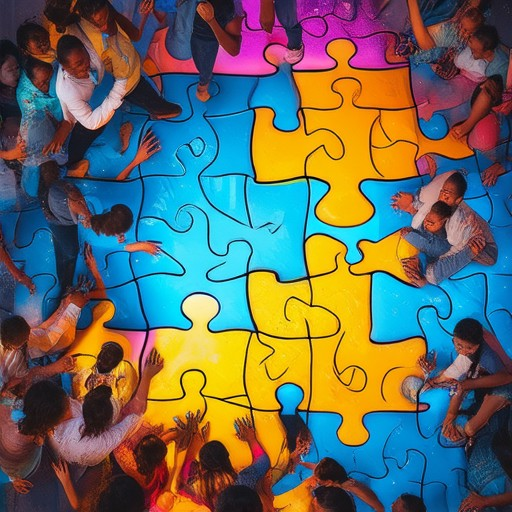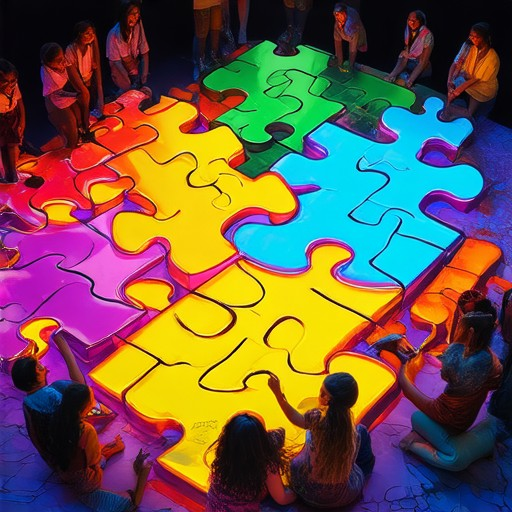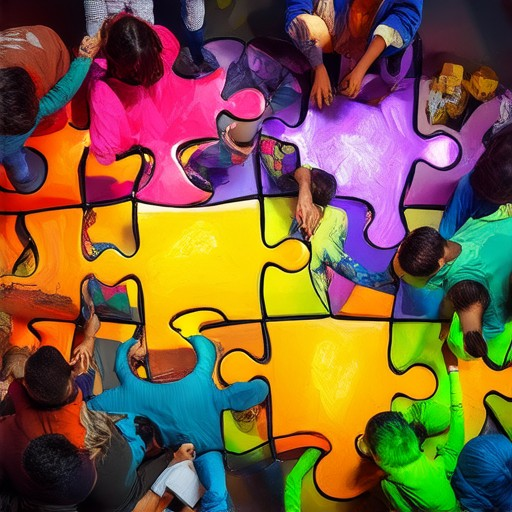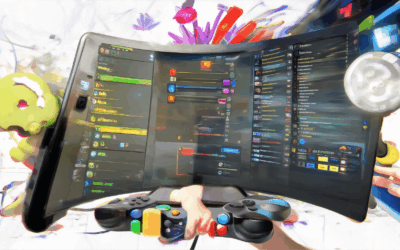Collaborative game projects have emerged as a powerful tool for fostering teamwork, creativity, and problem-solving skills across various settings. Whether in educational classrooms, corporate meetings, or social gatherings, these interactive experiences offer a unique way to break down barriers and build stronger connections. From board games to video games, cooperative activities to physical challenges, the possibilities for collaborative gameplay are vast and versatile. In this article, we’ll explore the top collaborative game projects designed to ignite teamwork, enhance communication, and inspire innovation among participants of all ages. We’ll delve into the best team-building exercises, discover the big five teamwork activities, and learn how to implement quick and effective icebreakers that make any setting more dynamic. By understanding the significance of collaboration and its impact on personal and professional growth, we aim to equip you with actionable strategies to succeed in any team environment. Let’s dive into the world of collaborative game projects and unlock the potential for meaningful teamwork.
Key Takeaways
- Encourages Reflection and Connection: The 30 Second Game fosters meaningful discussions by prompting participants to reflect on their most cherished moments, enhancing team bonding and communication.
- Boosts Energy and Creativity: With quick icebreaker activities like Trivia, Two Truths and a Lie, and Guess the Movie, teams engage dynamically, sparking creativity and breaking the ice effectively.
- Fosters Collaboration and Trust: The Clueless Game challenges teams to work together while isolating one member, promoting collaboration, trust, and problem-solving skills through dynamic interactions.
- Provides Diverse Team-Building Tools: From reflection exercises to competitive icebreakers, these games cater to various needs, offering adaptable options for enhancing teamwork and morale across different settings.

Example of a Collaborative Game
A collaborative game is an interactive activity where players work together towards achieving a common goal. One notable example is Minecraft , a sandbox video game that allows players to collaborate in building structures, exploring environments, and completing challenges. In this game, teamwork is essential, as players can combine their efforts to construct elaborate builds, survive threats, or solve puzzles.
Minecraft exemplifies the power of collaboration through its multiplayer mode, enabling players from around the world to join forces and create something extraordinary. This shared creativity and teamwork highlight the unique potential of collaborative gaming experiences.
What Are Some Good Team Building Games?
Team-building games are a fantastic way to foster collaboration, trust, and camaraderie among team members. Here are some excellent options to consider:
- Collaborative Games: These games require teamwork and problem-solving skills. Examples include:
- Puzzle games like “Jenga” or “Mystery Map”
- Escape room challenges
- Board games such as “Settlement of the Four” or “Catan Junior”
- Communication Games: These focus on verbal and non-verbal communication. Popular choices include:
- “Guess Who?” for icebreakers
- Pictionary or Charades for creative expression
- The “Never Have I Ever” game for sharing personal experiences
- Physical Games: Active games that encourage movement and energy release:
- Dance-offs or karaoke competitions
- Relay races or tug-of-war
- Simon Says or Follow the Leader
- Problem-Solving Games: Challenges that test critical thinking and adaptability:
- Escape rooms or treasure hunts
- Maze-solving or puzzle challenges
- Strategy-based board games
- Role-Playing Games: Immerse teams in scenarios to boost creativity and leadership:
- Scenario-based role plays
- Character-building exercises
- Storytelling contests
When selecting team-building games, consider factors like team size, available time, and the group’s dynamic. Mixing different types of games ensures variety and keeps the team engaged. For more resources and game ideas, explore our Indie Dev Games collection.

What Are the Big Five Teamwork Activities?
The “Big Five” teamwork activities are essential exercises designed to enhance collaboration, communication, and problem-solving within groups. These activities focus on five key areas: communication, trust-building, problem-solving, adaptability, and conflict resolution.
- Communication Activities :
- These exercises emphasize effective verbal and non-verbal communication. Examples include group discussions, role-playing scenarios, and brainstorming sessions where team members actively listen and contribute ideas.
- Trust-Building Activities :
- These initiatives foster trust and camaraderie. Activities may involve sharing personal experiences, strengths, or vulnerabilities in a safe and supportive environment to encourage transparency and reliability among team members.
- Problem-Solving Activities :
- These exercises challenge teams to collaborate on complex problems. Puzzles, strategy games, and collaborative tasks requiring creative thinking are common, helping teams develop coordinated approaches to challenges.
- Adaptability Activities :
- These exercises prepare teams to handle change and uncertainty. Simulations, quick-pivot scenarios, and flexible problem-solving exercises help build resilience and adaptability in dynamic situations.
- Conflict Resolution Activities :
- These activities focus on managing disagreements constructively. Role-playing, discussion forums, and debriefing sessions allow teams to practice resolving conflicts amicably and move forward positively.
By participating in these activities, teams can strengthen their bonds, improve their ability to work together, and become more resilient in facing various challenges. For further exploration of teamwork resources, visit Indie Dev Games , a platform dedicated to empowering game developers with valuable insights and tools.

What is the 30 Second Game for Team Building?
The 30 Seconds Left Game is a popular team-building exercise designed to encourage reflection and connection among participants. Here’s a detailed breakdown:
- Objective : Participants are asked to reflect on their lives and select the single moment they would relive if given only 30 seconds to live. This creates a meaningful discussion about priorities and memories.
- Steps :
- Begin by having each participant individually reflect on their life experiences.
- After some time, ask them to filter these experiences and choose the one they would most want to relive.
- Share their choices with the group, fostering deeper connections and conversations.
This game is excellent for encouraging open communication and helping teams understand each other’s values and priorities. For more team-building resources and guides, visit Indie Dev Games .
Additionally, check out similar team-building exercises on platforms like TeamBuilding.com and Activity Allies for inspiration and variety.
What is the 5 Minute Ice Breaker Activity?
An icebreaker activity is a quick and simple game or exercise designed to help people connect, ease tension, or spark conversation. A 5-minute icebreaker is specifically timed to be brief yet effective, making it ideal for quick team-building sessions or casual gatherings.
Here are some popular 5-minute icebreaker ideas:
- Trivia Game : Split participants into teams and ask quick trivia questions about general knowledge, pop culture, or specific topics. Points can be awarded based on correct answers, and the team with the most points wins.
- Two Truths and a Lie : Each participant shares two true facts about themselves and one false statement. Others guess which part is the lie to add a fun twist.
- Guess the Movie : Present participants with visual or verbal clues related to movie titles, characters, or plotlines, and they guess the correct one within the time limit.
- Would You Rather? : Ask quick hypothetical questions, such as “Would you rather live in a world with no chocolate or no coffee?” to spark lively debates and discussions.
- Quick Draw : Participants draw a picture based on a given phrase or category within a limited timeframe, often leading to humorous and creative results.
These activities are designed to be fast-paced and engaging, ensuring everyone gets involved without feeling pressured.

What is the Clueless Team-Building Game?
The Clueless team-building game is a dynamic and engaging activity designed to foster collaboration, communication, and problem-solving skills within a group. The game involves splitting participants into small teams, each tasked with solving a specific challenge or puzzle. One member from each team is designated as “the clueless” and is temporarily removed from their group, making them responsible for solving the problem while working independently.
How the Game Works
- Group Assignment: Participants are divided into smaller groups, each receiving a unique problem to solve.
- Nomination Process: Before seeing the problem, each group nominates one member to act as “the clueless” individual who will work alone to find the solution.
- Problem Presentation: The group members return to their respective groups to discuss the problem and devise a strategy, while “the clueless” works separately to uncover the solution.
- Solving Phase: After a set time, “the clueless” presents their solution to their group, who then collaborate to verify the correctness of the answer.
Variations and Complexity
The Clueless game can be adapted to varying levels of complexity depending on the group size and the type of problem presented. Some popular variations include:
- Time-Limited Challenges: Adding a strict time limit to increase the pressure and test the group’s ability to think critically under stress.
- Puzzle-Based Scenarios: Providing riddles, wordplay, or logic-based problems that require creative thinking and teamwork to solve effectively.
- Large-Scale Events: Organizing the game for larger groups by dividing them into multiple teams and incorporating competitive elements.
Benefits of the Clueless Game
- Enhances Communication: Encourages team members to articulate ideas clearly and work collaboratively toward a common goal.
- Fosters Trust: Creates opportunities for team members to rely on one another’s strengths and expertise, building trust within the group.
- Improves Problem-Solving Skills: Challenges participants to approach problems from different perspectives and develop innovative solutions.
- Promotes Creativity: The requirement for “the clueless” to solve the problem independently often sparks outside-the-box thinking and unconventional solutions.
Why Use the Clueless Game?
The Clueless team-building game is an excellent choice for organizations looking to boost morale, encourage teamwork, and inspire innovation among their employees. Whether used as an icebreaker during a conference or as a component of a larger team-building initiative, the game offers a unique and engaging way to strengthen bonds and enhance productivity.
Conclusion
The Clueless game is a versatile and interactive tool for fostering collaboration, communication, and critical thinking. By challenging teams to work together while isolating one member, it creates a dynamic environment that promotes growth and learning. Its adaptability makes it suitable for various settings and group sizes, making it a valuable addition to any organization’s team-building arsenal.




0 Comments